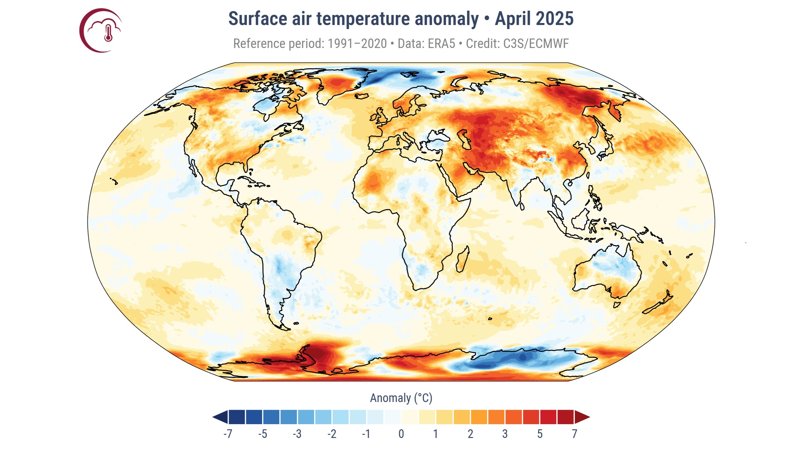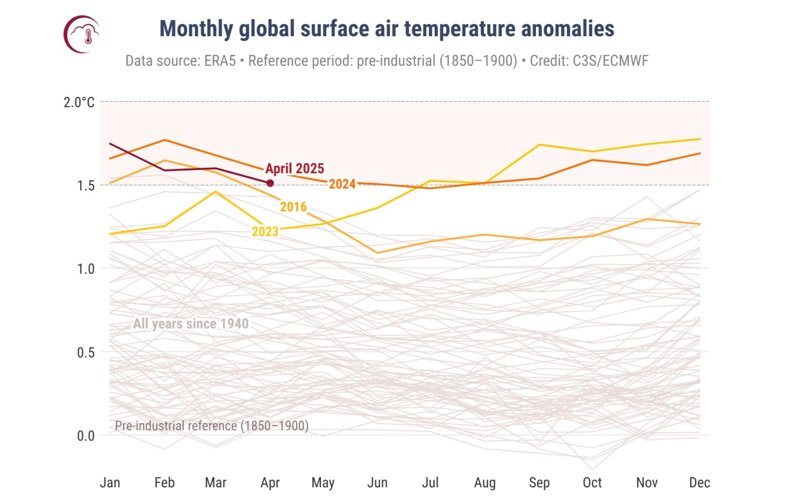April 2025 ranks as the second-hottest on record
April 2025 has claimed the second spot on the list of hottest Aprils ever recorded, according to the Copernicus Climate Change Service, Kazinform News Agency correspondent reports.

Meteorologists report that last month's surface air temperature reached 14.96°C. This is only 0.07°C lower than the record-breaking April 2024 and 0.07°C warmer than April 2016, which ranks third.
Experts note that the temperature exceeded the 1991-2020 average by 0.60°C and surpassed pre-industrial levels (1850-1900) levels by 1.51°C.
Scientists highlight a concerning trend: global temperatures have now remained above the critical 1.5°C threshold for 21 out of the last 22 months.

Temperature trends
Europe recorded an average temperature of 9.38°C in April 2025, exceeding the 1991-2020 average by 1.01°C. This marks the sixth warmest April in European meteorological history.
The most significant temperature anomalies were observed in Eastern Europe, Western Russia, Kazakhstan, and Norway. Meanwhile, Turkey, eastern parts of Bulgaria and Romania, the Crimean Peninsula, and northern Fennoscandia experienced below-average temperatures.
Temperatures were significantly above average over the Russian Far East, extensive areas of Central and Western Asia, most of North America, parts of Australia, and the Antarctic Peninsula including Western Antarctica.
Conversely, temperatures fell below average in southern South America, eastern Canada, the Great Lakes region, Hudson Bay area, northeastern Greenland, Svalbard, northern Australia, and East Antarctica.

Ocean temperatures and sea ice
The average sea surface temperature between 60°S and 60°N reached 20.89°C in April, ranking as the second highest on record for this month, just 0.15°C below April 2024's record.
Abnormally high sea temperatures persisted across numerous ocean basins, particularly in the northeastern Atlantic, which continued to break records. The Mediterranean Sea also remained significantly warmer than average, though not surpassing March records.
Arctic sea ice coverage continued its decline, with April levels 3% below average, the sixth lowest reading in 47 years of satellite monitoring. Particularly low ice concentrations were observed in the Barents and Okhotsk Seas, while the Greenland Sea showed abnormally high values. Antarctic sea ice measured 10% below average, marking the tenth lowest level on record.
Precipitation patterns
Drier-than-normal conditions dominated western North America, Central and East Asia, southern Australia, Madagascar, parts of South America, and across Central Europe, the UK, and southern Fennoscandia.
Wetter-than-average conditions were seen in parts of Canada, Alaska, mid-west USA, eastern and central Russia, southern Africa, northern Australia, central South America, as well as Southern Europe, northern Norway, southern Finland, and western Russia. The Alpine region saw heavy rains triggering floods, landslides, and avalanches.
Earlier, Kazinform News Agency reported that two-thirds of global warming is caused by world’s richest 10%.
